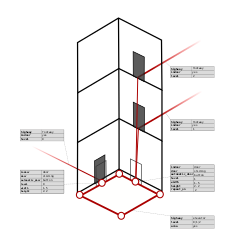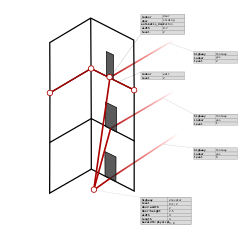Proposal:Elevator dimensions
| Elevator dimensions | |
|---|---|
| Proposal status: | Approved (active) |
| Proposed by: | Wielandb on behalf of OPENER |
| Applies to: | |
| Definition: | Ways of tagging the dimensions of an elevator. |
| Rendered as: | hidden |
| Draft started: | 2023-11-28 |
| RFC start: | 2024-01-31 |
| Vote start: | 2024-03-08 |
| Vote end: | 2024-03-25 |
Proposal
This proposal aims to establish a standardized way on how to record the dimensions of an elevator (highway=elevator), this applies to both the cage/car and the door. In detail this proposal introduces the tags width=*, length=*, diameter=* and height=* to record the dimensions of the elevator’s cage. Likewise door:width=* and door:height=* are used to record the dimensions of the open door as it can be smaller than the cage itself. It also proposes the tags maxwidth:physical=*, maxlength:physical=*, maxdiameter:physical=* and maxheight:physical=* to record the maximum usable space of the cage. These measurements can differ from the elevator dimensions due to fixtures like handrails.
Rationale
This information is important for routing wheelchair users as well as people with e.g. bikes or strollers, as the dimensions of an elevator might restrict them from entering or turning inside the elevator. The height can be used to calculate if a large object like a bicycle can be transported vertically inside the elevator.
Tagging

To closely represent as many elevators as possible while also keeping the tagging scheme simple for the usual case, multiple levels of detail are introduced:
- Map elevator as
 with cabin and door dimensions tags (LOD1)
with cabin and door dimensions tags (LOD1) - Map elevator as
 with separate door
with separate door  tagged with door dimensions (LOD2)
tagged with door dimensions (LOD2) - Map hoistway as
 enclosing or walling of LOD1/LOD2 with the hoistway door
enclosing or walling of LOD1/LOD2 with the hoistway door  tagged with door dimensions (LOD3)
tagged with door dimensions (LOD3)
Tags for highway=elevator that apply to all level of details:
height=*- The total measurement in the direction perpendicular to the floor. Also know as the inner height or clear height of the cage.maxheight:physical=*- The maximum usable height that is available across the whole area of the elevator. This means the baseheight=*minus any obstructions reaching into the elevator cabin, like a lamp. Tagging this is only useful if it differs fromheight=*by more than 5 centimeters.
Map elevator as Node  (LOD1)
(LOD1)
door:width=*- The inner width (clear width) of the entrance/exit.door:height=*- The inner height (clear height) of the entrance/exit.
Rectangular shape
length=*- The total measurement of the floor in the direction someone enters or exits the elevator. Usually understood as the depth of the elevator.
width=*- The total measurement of the floor perpendicular to the direction someone enters or exits the elevator.maxlength:physical=*- The maximum usable space in the direction someone enters or exits that is available on the whole height of the elevator. This means the baselength=*minus any obstructions reaching into the elevator cabin, like handrails or control consoles. Tagging this is only useful if it differs fromlength=*by more than 5 centimeters.maxwidth:physical=*- The maximum usable space perpendicular to the direction someone enters or exits that is available on the whole height of the elevator. This means the basewidth=*minus any obstructions reaching into the elevator cabin, like handrails or control consoles. Tagging this is only useful if it differs fromwidth=*by more than 5 centimeters.
Circular shape
diameter=*- The distance between the elevator walls measured through the center of the elevator. The presence ofdiameter=*implies that the elevator has a circular shape soshape=circularcan be omitted. Note that thediameter=*unit defaults to mm. So if measuring in meters be sure to add the unit at the end.maxdiameter:physical=*- The maximum usable space between the elevator walls measured through the center that is available on the whole height of the elevator. This means the basediameter=*minus any obstructions reaching into the elevator cabin, like handrails or control consoles. To align with the existingdiameter=*tag the default unit is in mm. Tagging this is only useful if it differs fromdiameter=*by more than 5 centimeters.

Map elevator as closed Way  (LOD2)
(LOD2)
The above tagging scheme cannot sufficiently represent every case that exists in reality.
In special cases we recommend mapping highway=elevator as an ![]() and adding separate entrance node(s)
and adding separate entrance node(s) ![]() tagged with
tagged with indoor=door or entrance=* and repeat_on=*. Make sure the node(s) are part of the highway=elevator way. This makes it clear for data consumers that these doors belong to the elevator. The door dimensions are then tagged by adding width=* and height=* to the door node(s). We also recommend adding door=* and automatic_door=*. The highway=elevator should be tagged with area=yes to clearly distinguish them from inclined elevators.
The elevator area still allows the deduction/calculation of dimensions like the inner smallest rectangle as well as other accessibility assessments.
Other elevator shapes
Not all elevators are rectangular or circular. Specially shaped elevators may be built due to lack of space or simply for artistic reasons.
Examples:
- Semi circle + rectangle: https://miro.medium.com/v2/resize:fit:720/format:webp/1*9SdkFJocpf5v5swrgBQUcQ.jpeg
- Even triangular ones: https://www.reddit.com/r/interestingasfuck/comments/2tur88/triangle_elevator/
Elevators with doors on adjacent sides
For elevators with doors located perpendicular to each other (see https://www.youtube.com/watch?v=3A4pou9L3cU), width and length become ambiguous. In addition the dimensions of the two elevator doors may be different.
Map elevator and hoistway  (LOD3)
(LOD3)

Outer doors with different dimensions or different type
The stationary doors in the hoistway wall on each level (outer doors) can differ from the door(s) that is part of and moves with the elevator cabin (inner door). Possible differences are the door size (width=*/height=*), whether it has to be opened manually (automatic_door=no) or if it requires a key (locked=yes). As with the other tags, this is relevant so routing engines can decide whether a person may or may not be able to leave the elevator at a particular level.
In such case another level of detail is introduced by additionally mapping the hoistway wall (indoor=wall unless the wall is already described by an adjoining element like indoor=room) for the particular level and its respective door (indoor=door). The outer door ![]() should be connected to either the inner door
should be connected to either the inner door ![]() or the elevator via a
or the elevator via a highway=footway or highway=path ![]() .
.
Rendering
No rendering is suggested.
Features/Pages affected
External discussions
Comments
Please comment on the discussion page.
Voting
Voting on this proposal has been closed.
It was approved with 22 votes for, 0 votes against and 0 abstentions.
 I approve this proposal. Nicely fleshed out! --Flo Edelmann (talk) 10:35, 8 March 2024 (UTC)
I approve this proposal. Nicely fleshed out! --Flo Edelmann (talk) 10:35, 8 March 2024 (UTC) I approve this proposal. But please consider adding the diagonal of rectangular cabins. This is frequently a decisive factor for cyclists in train station elevators --voschix (talk) 15:02, 8 March 2024 (UTC)
I approve this proposal. But please consider adding the diagonal of rectangular cabins. This is frequently a decisive factor for cyclists in train station elevators --voschix (talk) 15:02, 8 March 2024 (UTC) I approve this proposal. --scai (talk) 15:15, 8 March 2024 (UTC)
I approve this proposal. --scai (talk) 15:15, 8 March 2024 (UTC) I approve this proposal. -- Something B (talk) 21:17, 8 March 2024 (UTC)
I approve this proposal. -- Something B (talk) 21:17, 8 March 2024 (UTC) I approve this proposal. --Woazboat (talk) 22:10, 8 March 2024 (UTC)
I approve this proposal. --Woazboat (talk) 22:10, 8 March 2024 (UTC) I approve this proposal. (I assume that aspects of the illustrations not mentioned as changes in the proposal text are examples and not normative.) --Tordanik 10:15, 9 March 2024 (UTC)
I approve this proposal. (I assume that aspects of the illustrations not mentioned as changes in the proposal text are examples and not normative.) --Tordanik 10:15, 9 March 2024 (UTC) I approve this proposal. B-unicycling (talk) 00:43, 10 March 2024 (UTC)
I approve this proposal. B-unicycling (talk) 00:43, 10 March 2024 (UTC) I approve this proposal. --AmOosm (talk) 16:33, 10 March 2024 (UTC)
I approve this proposal. --AmOosm (talk) 16:33, 10 March 2024 (UTC) I approve this proposal. --Bkil (talk) 09:02, 11 March 2024 (UTC)
I approve this proposal. --Bkil (talk) 09:02, 11 March 2024 (UTC) I approve this proposal. --Chris2map (talk) 16:34, 11 March 2024 (UTC)
I approve this proposal. --Chris2map (talk) 16:34, 11 March 2024 (UTC) I approve this proposal. --Rskedgell (talk) 11:54, 12 March 2024 (UTC)
I approve this proposal. --Rskedgell (talk) 11:54, 12 March 2024 (UTC) I approve this proposal. --El indy (talk) 12:00, 13 March 2024 (UTC)
I approve this proposal. --El indy (talk) 12:00, 13 March 2024 (UTC) I approve this proposal. --Fiszi37 (talk) 17:42, 13 March 2024 (UTC)
I approve this proposal. --Fiszi37 (talk) 17:42, 13 March 2024 (UTC) I approve this proposal. --Urbalazs (talk) 00:47, 14 March 2024 (UTC)
I approve this proposal. --Urbalazs (talk) 00:47, 14 March 2024 (UTC) I approve this proposal. --Makiwolf (talk) 16:49, 17 March 2024 (UTC)
I approve this proposal. --Makiwolf (talk) 16:49, 17 March 2024 (UTC) I approve this proposal. --MattPoulidor
I approve this proposal. --MattPoulidor I approve this proposal. --EneaSuper (talk) 09:00, 18 March 2024 (UTC)
I approve this proposal. --EneaSuper (talk) 09:00, 18 March 2024 (UTC) I approve this proposal. --CaldeiraG (talk) 09:22, 18 March 2024 (UTC)
I approve this proposal. --CaldeiraG (talk) 09:22, 18 March 2024 (UTC) I approve this proposal. –Gymate (talk) 09:26, 18 March 2024 (UTC)
I approve this proposal. –Gymate (talk) 09:26, 18 March 2024 (UTC) I approve this proposal. --Zevelyne (talk) 13:40, 19 March 2024 (UTC)
I approve this proposal. --Zevelyne (talk) 13:40, 19 March 2024 (UTC) I approve this proposal. OPTIONAL MESSAGE HERE --Reinhard12 (talk) 21:29, 23 March 2024 (UTC)
I approve this proposal. OPTIONAL MESSAGE HERE --Reinhard12 (talk) 21:29, 23 March 2024 (UTC) I approve this proposal. --快乐的老鼠宝宝 (talk) 18:20, 24 March 2024 (UTC)
I approve this proposal. --快乐的老鼠宝宝 (talk) 18:20, 24 March 2024 (UTC) I approve this proposal. As the developer of MapComplete: similar tagging has been in there for a while now; i've updated the tagging to reflect this one. Pietervdvn (talk) 00:33, 25 March 2024 (UTC)
I approve this proposal. As the developer of MapComplete: similar tagging has been in there for a while now; i've updated the tagging to reflect this one. Pietervdvn (talk) 00:33, 25 March 2024 (UTC)